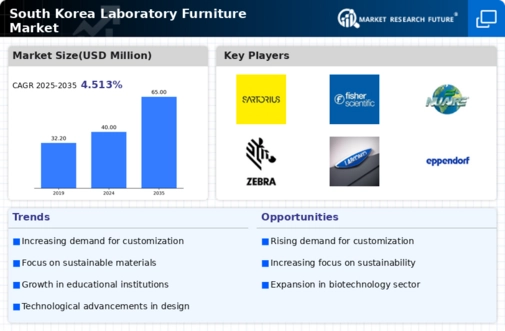Rising Demand for Advanced Research Facilities
The laboratory furniture market in South Korea is experiencing a notable surge in demand due to the establishment of advanced research facilities. As the nation invests heavily in scientific research and development, the need for specialized laboratory environments increases. This trend is reflected in the growing number of research institutions and universities, which require high-quality laboratory furniture to support their operations. According to recent data, the investment in R&D in South Korea has reached approximately $20 billion, indicating a robust commitment to enhancing research capabilities. Consequently, the laboratory furniture market is poised for growth as institutions seek to equip their facilities with modern, efficient, and durable furniture that meets the specific needs of various scientific disciplines.
Technological Advancements in Laboratory Design
Technological advancements are reshaping the laboratory furniture market in South Korea, as innovative designs and materials become more prevalent. The integration of smart technologies into laboratory furniture, such as adjustable workstations and modular designs, enhances functionality and adaptability. This trend is particularly relevant in dynamic research environments where flexibility is crucial. Moreover, the use of sustainable materials in furniture production aligns with the growing emphasis on eco-friendly practices. As laboratories seek to modernize their facilities, the demand for technologically advanced furniture solutions is expected to rise, driving growth in the laboratory furniture market.
Increasing Investment in Educational Institutions
The laboratory furniture market is benefiting from the increasing investment in educational institutions across South Korea. As the government and private sector allocate more funds towards enhancing educational infrastructure, there is a corresponding need for modern laboratory facilities. This investment is particularly evident in STEM (Science, Technology, Engineering, and Mathematics) education, where practical laboratory experience is essential. Recent reports indicate that educational spending has risen by approximately 10% annually, leading to the renovation and construction of new laboratories. Consequently, the demand for high-quality laboratory furniture is likely to increase, as institutions strive to provide students with the best possible learning environments.
Growth of Biotechnology and Pharmaceutical Sectors
The laboratory furniture market is significantly influenced by the expansion of the biotechnology and pharmaceutical sectors in South Korea. With the country positioning itself as a leader in biopharmaceutical innovation, there is an increasing need for state-of-the-art laboratory environments. This growth is evidenced by the rise in the number of biotech firms, which has increased by over 15% in the past few years. As these companies establish new laboratories, they require high-quality furniture that can accommodate advanced equipment and facilitate efficient workflows. The laboratory furniture market is thus likely to benefit from this sector's expansion, as firms seek to create optimal research environments that support their innovative endeavors.
Increased Focus on Safety and Compliance Standards
Safety and compliance are paramount in laboratory settings, driving the laboratory furniture market in South Korea. Regulatory bodies have established stringent guidelines to ensure safe working environments, particularly in chemical and biological laboratories. As a result, laboratory furniture must adhere to these standards, which include fire resistance, chemical resistance, and ergonomic design. The market is witnessing a shift towards furniture that not only meets these safety requirements but also enhances user comfort and productivity. This focus on safety is likely to propel the demand for specialized laboratory furniture, as institutions prioritize compliance to avoid potential liabilities and ensure the well-being of their staff and researchers.






















Leave a Comment